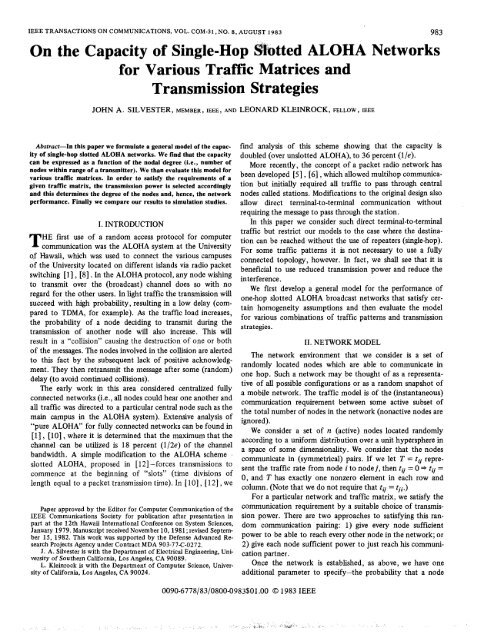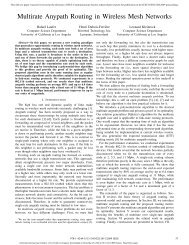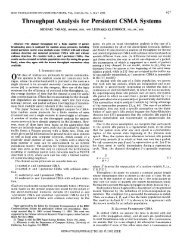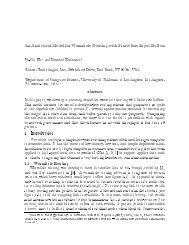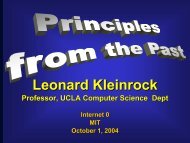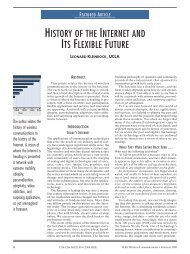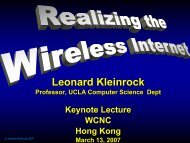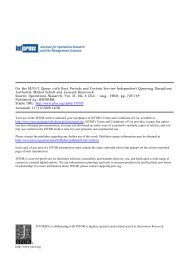On the Capacity of Single-Hop Slotted ALOHA - IEEE Xplore
On the Capacity of Single-Hop Slotted ALOHA - IEEE Xplore
On the Capacity of Single-Hop Slotted ALOHA - IEEE Xplore
You also want an ePaper? Increase the reach of your titles
YUMPU automatically turns print PDFs into web optimized ePapers that Google loves.
<strong>IEEE</strong> TRANSACTIONSCOMMUNICATIONS, ONVOL. COM-31, NO. 8, AUGUST 1983 983<strong>On</strong> <strong>the</strong> <strong>Capacity</strong> <strong>of</strong> <strong>Single</strong>-<strong>Hop</strong> gkotted <strong>ALOHA</strong> Networksfor Various Traffic Matrices andAbsrrucr-In this paper we formulate a general model <strong>of</strong> <strong>the</strong> capacity<strong>of</strong> single-hop slotted <strong>ALOHA</strong> networks. We find that <strong>the</strong> capacitycan be expressed as a function <strong>of</strong> <strong>the</strong> nodal degree (i.e., number <strong>of</strong>nodes within range <strong>of</strong> a transmitter). We than evaluate this model forvarious traffk matrices. In order to satisfy <strong>the</strong> requirements <strong>of</strong> agiven traffic matrix, <strong>the</strong> transmission power is selected accordinglyand this determines <strong>the</strong> degree <strong>of</strong> <strong>the</strong> nodes and, hence, <strong>the</strong> networkperformance. Finally we compare our results to simulation studies.TI. INTRODUCTIONHE first use <strong>of</strong> a random access protocol for computercommunication was <strong>the</strong> <strong>ALOHA</strong> system at <strong>the</strong> University<strong>of</strong> Hawaii, which was used to connect <strong>the</strong> various campuses<strong>of</strong> <strong>the</strong> University located on different islands via radio packetswitching [l],[8] . In <strong>the</strong> <strong>ALOHA</strong> protocol, any node wishingto transmit over <strong>the</strong> (broadcast) channel does so with noregard for <strong>the</strong> o<strong>the</strong>r users. In light traffic <strong>the</strong> transmission willsucceed with high probability, resulting in a low delay (comparedto TDMA, for example). As <strong>the</strong> traffic load increases,<strong>the</strong> probability <strong>of</strong> a node deciding to transmit during <strong>the</strong>transmission <strong>of</strong> ano<strong>the</strong>r node will also increase. This willresult in a “collision” causing <strong>the</strong> destruction <strong>of</strong> one or both<strong>of</strong> <strong>the</strong> messages. The nodes involved in <strong>the</strong> collision are alertedto this fact by <strong>the</strong> subsequent lack <strong>of</strong> positive acknowledgment.They <strong>the</strong>n retransmit <strong>the</strong> message after some (random)delay (to avoid continued collisions).The early work in this area considered centralized fullyconnected networks (i.e., all nodes could hear one ano<strong>the</strong>r andall traffic was directed to a particular central node such as <strong>the</strong>main campus in <strong>the</strong> <strong>ALOHA</strong> system). Extensive analysis <strong>of</strong>“pure <strong>ALOHA</strong>” for fully connected networks can be found in[l], [lo], where it is determined that <strong>the</strong> maximum that <strong>the</strong>channel canbe utilized is 18 percent (1/2e) <strong>of</strong> <strong>the</strong> channelbandwidth. A simple modification to <strong>the</strong> <strong>ALOHA</strong> scheme .slotted <strong>ALOHA</strong>, proposed in [12] -forces transmissions tocommence at <strong>the</strong> beginning <strong>of</strong> “slots” (time divisions <strong>of</strong>length equal to a packet transmission time). In [lo], [ 121, wePaper approved by <strong>the</strong> Editor for Computer Communication <strong>of</strong> <strong>the</strong><strong>IEEE</strong> Communications Society for publication after presentation inpart at <strong>the</strong> 12th Hawaii International Conference on System Sciences,January 1979. Manuscript received November 10,1981 ;revised September15, 1982. This work was supported by <strong>the</strong> Defense Advanced ResearchProjects Agency under Contract MDA 903-77C-0272.J. A. Silvester is with <strong>the</strong> Department <strong>of</strong> Electrical Engineering, University<strong>of</strong> Sou<strong>the</strong>rn California, Los Angeles, CA 90089.L. Kleinrock is with <strong>the</strong> Department <strong>of</strong> Computer Science, University<strong>of</strong> California, Los Angeles, CA 90024.find analysis <strong>of</strong> this scheme showing that <strong>the</strong> capacity isdoubled (over unslotted <strong>ALOHA</strong>), to 36 percent (l/e).More recently, <strong>the</strong> concept <strong>of</strong> a packet radio network hasbeen developed [5], [6] , which allowed multihop communicationbut initially required all traffic to pass through centralnodes called stations. Modifications to <strong>the</strong> original design alsoallow direct terminal-to-terminal communication withoutrequiring <strong>the</strong> message to pass through <strong>the</strong> station.In this paper we consider such direct terminal-to-terminaltraffic but restrict our models to <strong>the</strong> case where <strong>the</strong> destinationcan be reached without <strong>the</strong> use <strong>of</strong> repeaters (single-hop).For some traffic patterns it is not necessary to use a fullyconnected topology, however. In fact, we shall see that it isbeneficial to use reduced transmission power and reduce <strong>the</strong>interference.We first develop a general model for <strong>the</strong> performance <strong>of</strong>one-hop slotted <strong>ALOHA</strong> broadcast networks that satisfy certainhomogeneity assumptions and <strong>the</strong>n evaluate <strong>the</strong> modelfor various combinations <strong>of</strong> traffic patterns and transmissionstrategies.11. NETWORK MODELThe network environment that we consider is a set <strong>of</strong>randomly located nodes which are able to communicate inone hop. Such a network may be thought <strong>of</strong> as a representative<strong>of</strong> all possible configurations or as a random snapshot <strong>of</strong>a mobile network. The traffic model is <strong>of</strong> <strong>the</strong> (instantaneous)communication requirement between some active subset <strong>of</strong><strong>the</strong> total number <strong>of</strong> nodes in <strong>the</strong> network (nonactive nodes areignored).We consider a set <strong>of</strong> n (active) nodes located randomlyaccording to a uniform distribution over a unit hypersphere ina space <strong>of</strong> some dimensionality. We consider that <strong>the</strong> nodescommunicate in (symmetrical) pairs. If we let T = rij represent<strong>the</strong> traffic rate from node i to node j , <strong>the</strong>n tii = 0 * tii =0, and T has exactly one nonzero element in each row andcolumn. (Note that we do not require that rij = tji.)For a particular network and traffic matrix, we satisfy <strong>the</strong>communication requirement by a suitable choice <strong>of</strong> transmissionpower. There are two approaches to satisfying this randomcommunication pairing: 1) give every node sufficientpower to be able to reach every o<strong>the</strong>r node in <strong>the</strong> network; or2) give each node sufficient power to just reach his communicationpartner.<strong>On</strong>ce <strong>the</strong> network is established, as above, we have oneadditional parameter to specify-<strong>the</strong> probability that a node0090-6778/83/0800-0983$01 .OO 0 1983 <strong>IEEE</strong>’ ~ ... ._ i. ’ . , ..>&$‘,“..’ ,, . .>
984 <strong>IEEE</strong> TRANSACTIONS ON COMMUNICATIONS, VOL. COM-31, 8, AUGUST NO. 1983will transmit in any slot. (This corresponds to <strong>the</strong> <strong>of</strong>fered ference factor I. (In fact, 1 --I is <strong>the</strong> interference encounteredchannel traffic randomized so that slotted <strong>ALOHA</strong> will oper- by a node, and perhaps we should call I <strong>the</strong> noninterferenceate correctly and resolve previous conflicts due to simultane- factor!) We can think <strong>of</strong> this factor as background interferoustransmissions.) In order to compute <strong>the</strong> throughput, we ence. If weassume that <strong>the</strong> interference encountered at anyuse <strong>the</strong> “heavy traffic model,” which corresponds to assuming node is independent <strong>of</strong> <strong>the</strong> number <strong>of</strong> nodes that he hits, <strong>the</strong>nthat all (active) nodes are always busy, but which transmit in- <strong>the</strong> expected throughput for any node in <strong>the</strong> network, ynode,dependently in any given slot depending on this transmission is given byprobability. We denote <strong>the</strong> transmission probability for nodei as pi.nYnode =I x hkYkA. Nodal Throughputk=2Consider an arbitrary node (say node i) in <strong>the</strong> network.The probability that this node correctly transmits a packet tohis partner (say node j ) in any slot is given bywhere hk is <strong>the</strong> probability that a node hits k nodes when hetransmits (note that he always hits himself and his partner).si = Pr {i transmits} Pr { j does not transmit}Pr {none <strong>of</strong> j’s neighbors transmits}where Nj is <strong>the</strong> set <strong>of</strong> nodes that j can hear (excluding hispartner i). The assumption here is that reception is a discreteprocess, i.e., a node ei<strong>the</strong>r hears a transmission or does not.Thus, ano<strong>the</strong>r transmission ei<strong>the</strong>r causes interference or not,depending on whe<strong>the</strong>r he is more distant than <strong>the</strong> threshold<strong>of</strong> reception. In a real network this reception process is notdiscrete but depends on relative power levels, noise, multipath,etc.si is <strong>the</strong> rate at which node i succeeds in sending traffic tohis communication partner. Since we have a single-hop network,this corresponds to <strong>the</strong> throughput for this node, yi.If <strong>the</strong> network were multihop we would have to divide thissuccess rate by <strong>the</strong> path length in order to obtain end-to-endthroughput. Thus, <strong>the</strong> total network throughput y is given byn ny = yi = si.Since <strong>the</strong> networks we consider <strong>the</strong> homogeneous, <strong>the</strong> throughputfor all nodes is identically distributed; <strong>the</strong>refore, we drop<strong>the</strong> subscripts corresponding to <strong>the</strong> particular node underinvestigation, and ra<strong>the</strong>r consider <strong>the</strong> performance <strong>of</strong> a nodethat hits (i.e., interferes with or is heard by) a particular number<strong>of</strong> o<strong>the</strong>r nodes when he transmits. We modify our notationto let Pk be <strong>the</strong> transmission probability <strong>of</strong> a node that hits knodes when he transmits (including himself and his partner)and 7k to represent <strong>the</strong> throughput for a node which hitsk nodes. Making <strong>the</strong> assumption that both nodes <strong>of</strong> a partnershiphit <strong>the</strong> same number <strong>of</strong> nodes (this is not valid, but oursimulations show it to be a reasonable simplifying assumption),or at least that <strong>the</strong>y use <strong>the</strong> same transmission probability,we obtain <strong>the</strong> following expression for <strong>the</strong> throughput:111. THE INTERFERENCE FACTORI is <strong>the</strong> product <strong>of</strong> terms corresponding to <strong>the</strong> interferencegenerated by <strong>the</strong> nodes that are heard by <strong>the</strong> destination. Wecan group <strong>the</strong>se terms depending on <strong>the</strong> number <strong>of</strong> nodes that<strong>the</strong> source <strong>of</strong> <strong>the</strong> interference hits when he transmits. We defineIk to be <strong>the</strong> total interference contribution <strong>of</strong> nodes thathit k nodes when <strong>the</strong>y transmit. Let us call a node that hits ko<strong>the</strong>rs when he transmits a “k-hitter.” Thenn- 2Ik = Pr {a node hears j k-hitters} (1 -pk)’. (5 1j= 0The total interference will <strong>the</strong>n be <strong>the</strong> product <strong>of</strong> <strong>the</strong>se factors.We define Hik to be <strong>the</strong> probability that an arbitrary nodehears j k-hitters. We can evaluate this as follows:n- 2Hik = x Pr {Total <strong>of</strong> 1 k-hitters} Pr {hear j <strong>of</strong> 1)Z=jWe thus have.(;)( ”)j (-- k - 2)”n-2 n-2where we have collected <strong>the</strong> interference terms from nodeso<strong>the</strong>r than <strong>the</strong> node itself and his partner into <strong>the</strong> inter-
SILVESTER AND KLEINROCK: SINGLE-HOP SLOTTED <strong>ALOHA</strong> NETWORKS 985We can switch <strong>the</strong> order <strong>of</strong> summation to getnode is= p(l -py- (1 3)which is <strong>the</strong> well-known slotted <strong>ALOHA</strong> result and reduces tol/ne forp = l/n and large n.V. ADJUSTABLE TRANSMITTER POWERAno<strong>the</strong>r approach for arbitrary traffic matrices is to limit<strong>the</strong> power <strong>of</strong> each transmitter so that it exactly reaches itsdestination (again assuming that reception is a two-state process,ei<strong>the</strong>r you can or cannot hear a transmission) [14]. InFig. 1 we show a randomly generated two-dimensional network<strong>of</strong> ten nodes connected in this manner; <strong>the</strong> lines joiningpairs <strong>of</strong> nodes represent <strong>the</strong> traffic matrix and, hence, <strong>the</strong>transmission radii (e.g., nodes 3 and 9 are a communicatingPair).A. Analytical ModelThus, <strong>the</strong> interference factorI is given byFor large n, we can use <strong>the</strong> exponential approximation to findnWe now proceed to find <strong>the</strong> hitting distribution hk. Consideran arbitrary node P in <strong>the</strong> network and rank <strong>the</strong> n - 1o<strong>the</strong>r nodes in order <strong>of</strong> <strong>the</strong>ir distance from P. If P is pairedwith a node in <strong>the</strong> (k + 1)st position in this list (i.e., his kthneighbor), he will interfere with (hit) exactly k + 1 nodeswhen he transmits. By assumption, P is' equally likely to bepaired with any <strong>of</strong> <strong>the</strong> nodes, and so <strong>the</strong> hitting distribution isgiven byThe nodal throughput for an n-node network is given byWe must now select an appropriate set <strong>of</strong> values for pk. Inorder for <strong>the</strong> sum <strong>of</strong> <strong>the</strong> exponent <strong>of</strong> (11) to be bounded,pkmust be O(l/k). We thus select Pk = l/k and note that thissomehow corresponds to <strong>the</strong> optimality condition G = 1 in[2] . With <strong>the</strong>se values for pk and hk, <strong>the</strong> sum in <strong>the</strong> exponents<strong>of</strong> (1 1 ) isWe now use this model to investigate <strong>the</strong> throughput properties<strong>of</strong> several configurations.IV. COMPLETELY CONNECTED TOPOLOGIES<strong>On</strong>e approach to satisfying an arbitrary random trafficmatrix is to give every node sufficient transmission power sothat all <strong>the</strong> nodes in <strong>the</strong> network hear when any one transmits.This corresponds to <strong>the</strong> model <strong>of</strong> [ 13 , [2] , [12] and <strong>the</strong> totalnetwork throughput will <strong>the</strong>refore approach l/e. We proceedto show that our approach is consistent with this result.Since <strong>the</strong> environment for each node is identical, we assumepi = p . The number <strong>of</strong> nodes that can interfere with a giventransmission is n - 1 , i.e., h, = 1 . The throughput for each-I n - 2 0 (log n)n+- n-1 n-1= Gm [=1and so <strong>the</strong> interference factor will be1I = - (for large networks).e
986 <strong>IEEE</strong> TRANSACTIONS ON COMMUNICATIONS,VOL. COM-31,8, AUGUST NO. 1983Fig. 1.Ten node limited power network.We can now evaluate (12) to obatin <strong>the</strong> total network throughput.1 k-2 1 1 n-2Ynode =-[fi (l -- --) ]n-1 k=3 n-2 k n-1k=2 kSince <strong>the</strong> throughput for each node is identically distributed,<strong>the</strong> total network throughput y will be given by nynode.. = q q - --) 1 n-2 3n-1 k=3 k-2 - k 1 n-1 n-2Summing <strong>the</strong>se series [4] and performing some algebraicmanipulation, we find that <strong>the</strong> asymptotic behavior for large .networks is given bylog (n) + c-- 71’6lim y= (1 9)n-00 ewhere C is Euler’s constant. This can be approximated bylog (n) - 17% eThe above results were derived with no reference to <strong>the</strong>dimensionality <strong>of</strong> <strong>the</strong> network. We can <strong>the</strong>refore achieve athroughput logarithmically proportional to <strong>the</strong> network sizefor all networks satisfying a uniform traffic pattern by exactadjustment <strong>of</strong> transmission range. It must be pointed out,however, that <strong>the</strong> throughput for all pairs <strong>of</strong> nodes in <strong>the</strong> networkis not <strong>the</strong> same. Nodes that are close toge<strong>the</strong>r (and, thus,have high transmission probabilities since <strong>the</strong>y do not interferewith many o<strong>the</strong>r nodes) will achieve higher throughputs thanthose that are far apart (recall that <strong>the</strong> background interferenceis assumed to be uniform for all nodes in <strong>the</strong> network).Even <strong>the</strong> node with <strong>the</strong> smallest throughput (in <strong>the</strong> worst casethis node will hit n - 2 o<strong>the</strong>r nodes) will have a throughput <strong>of</strong>l/ne for large networks, which is <strong>the</strong> same as that for <strong>the</strong> fullyconnected case (in which every node achieves a throughput<strong>of</strong> llne). Thus, <strong>the</strong> node experiencing <strong>the</strong> worst performancewill be doing no worse than for <strong>the</strong> fully connected case,whereas nodes close toge<strong>the</strong>r will far exceed this throughput.B. SimulationIn order to check <strong>the</strong> validity <strong>of</strong> this model, we developeda simulation program to compute <strong>the</strong> throughputs for <strong>the</strong>senetworks. This program operates as follows (described for atwo-dimensional network).A random network is generated with points uniformlydistributed inside <strong>the</strong> unit circle. Pairs are <strong>the</strong>n randomlyassigned; in fact, we pair node 1 to node 2, node 3 to node 4,and so on (this being a perfectly random pairing). With thispairing, <strong>the</strong> transmission radii are. determined so that communicationcan take place, and <strong>the</strong> adjacency matrix is com-puted. We <strong>the</strong>n compute <strong>the</strong> transmission probability for anode to be <strong>the</strong> reciprocal <strong>of</strong> <strong>the</strong> number <strong>of</strong> nodes within range<strong>of</strong> that node. From this we can compute <strong>the</strong> success probabilitiesfor each node and, hence, <strong>the</strong> network throughput. Thesedata are <strong>the</strong>n averaged over several runs (i.e., over severalrandom networks and pairings).In Fig. 2 we plot <strong>the</strong> model and simulation results for onedimensionalnetworks averaged over 50 networks for eachdata point. We see excellent agreement between model andsimulation. The agreement is less good for small networkssince edge effects are significant (i.e., a large proportion <strong>of</strong> <strong>the</strong>nodes are close to <strong>the</strong> edge <strong>of</strong> <strong>the</strong> network). Nodes near <strong>the</strong>edge <strong>of</strong> <strong>the</strong> network suffer less interference than is predictedby our assumption <strong>of</strong> <strong>the</strong> background interference being constant.As <strong>the</strong> number <strong>of</strong> nodes increases; <strong>the</strong>se edge effectsbecome proportionately less important. In <strong>the</strong> simulation, <strong>the</strong>transmission probability was p = l/k, where k is <strong>the</strong> number<strong>of</strong> nodes hit by <strong>the</strong> transmission and partners not necessarilyusing <strong>the</strong> same k.Fig. 3 shows similar results for <strong>the</strong> two-dimensional case.We again notice good agreement between <strong>the</strong> model and <strong>the</strong>simulation results for large n. In two dimensions <strong>the</strong> modelrequires larger networks before <strong>the</strong> agreement is good, due to<strong>the</strong> higher proportion <strong>of</strong> nodes on <strong>the</strong> edge <strong>of</strong> <strong>the</strong> area whichsuffer less interference. It is for this reason that <strong>the</strong> simulationresults exceed that predicted by <strong>the</strong> model for small networks.C. O<strong>the</strong>r Transmission PoliciesIn addition to using <strong>the</strong> transmission policy <strong>of</strong> p = l/k, wehavealso investigated several o<strong>the</strong>rs, as outlined below. Theperformance <strong>of</strong> <strong>the</strong> following schemes is shown in Figs. 4-6.
SILVESTER AND KLEINROCK: SINGLE-HOP SLOTTED <strong>ALOHA</strong> NETWORKS 987125' l15o -Y. /-Model. Sirnula1,onFig. 2.0.c 0 VJ20 &I 69 E3 100 120 IPO 160n<strong>On</strong>e-dimensional random network-throughput.nFig. 4. Fixed transmission probability.Y0.25 -001 ' I I I0 20 40 60 80 100 120 140 160nFig. 5. Transmission probability based on hearing-degree.Fig. 3.O O K " " " ' ~0 20 40 60 80 100 120 140 160nTwo-dimensional random network-throughput.1) Fixed Transmission Probability: If we use as fixed transmissionprobability (independent <strong>of</strong> <strong>the</strong> hitting degree and <strong>the</strong>network size), <strong>the</strong> throughput as a function <strong>of</strong> network sizerapidly falls to zero since too much interference is generated.Substituting fixed pk = p and hk = l/n - 1 into our model(1 2), we havenAs an example, we set p = 112 and findWe plot this in Fig. 4, along with corresponding simulationresults.2) Hearing Degree: We also tried using <strong>the</strong> hearing degreera<strong>the</strong>r than <strong>the</strong> hitting degree for determining <strong>the</strong> transmissionprobability. Fig. 5 shows <strong>the</strong> performance for <strong>the</strong> case where anode uses its own hearing degree to determine <strong>the</strong> transmissionprobability. We see that <strong>the</strong> throughput is independent <strong>of</strong> <strong>the</strong>network size and appears to be constant at 2/e. A justification<strong>of</strong> this is that <strong>the</strong> number heard has mean n/2 and that<strong>the</strong> distribution has a sharp peak for large n (see <strong>the</strong> Appendix).Each node, <strong>the</strong>refore, hears n/2 nodes, each <strong>of</strong> whichtransmits with probability 2/n. The network throughput is thus3) Estimated Degree: From a practical (implementation)point <strong>of</strong> view, it may be difficult for a node to determineexactly how many nodes hear when it transmits. We triedusing an estimate <strong>of</strong> <strong>the</strong> hitting degree, equal to <strong>the</strong> numberexpected to be within range based on <strong>the</strong> transmission powerand density <strong>of</strong> nodes (both quantities would probably beavailable to a node in a real network). Fig. 6 shows <strong>the</strong> performance<strong>of</strong> this scheme and we find, as expected, that <strong>the</strong>throughput grows logarithmically with <strong>the</strong> network size (notethat for this case both nodes <strong>of</strong> a partnership will use <strong>the</strong> sametransmission probability). We note that <strong>the</strong> performance isnot quite as good for this scheme as when we used <strong>the</strong> actualhitting degree. This is probably mainly due to edge effectswhere <strong>the</strong> nodes actually have lower degrees than would be expected(and also suffer from less interference).VI. BEST TRAFFIC MATRIXIn <strong>the</strong> previous discussion <strong>the</strong> transmission range was determinedby <strong>the</strong> traffic matrix. Since we did not allow multihoppaths, we required that <strong>the</strong> transmission power <strong>of</strong> a nodebe exactly sufficient to reach his communication partner. Bychanging <strong>the</strong> traffic matrix we can <strong>the</strong>refore fur<strong>the</strong>r reduce<strong>the</strong> transmission ranges. We study this problem in this section,attempting to answer <strong>the</strong> following question: for a randomplacement <strong>of</strong> nodes, what traffic ma& allows <strong>the</strong> highesttraffic levels to be supported [ 131 ? We note here that we onlyneed consider one-hop communication, since we could iniproveany multihop configuration (to achieve a higher throughputin terms <strong>of</strong> end-to-end messages) by considering each hop<strong>of</strong> <strong>the</strong> message to be a separate message. The performance<strong>of</strong> <strong>the</strong> best traffic matrix is somehow a measure <strong>of</strong> <strong>the</strong> networktopology. It corresponds to <strong>the</strong> total capacity (summedover all links) in a traditional network, since <strong>the</strong> best trafficmatrix for a traditional network is to send traffic to all neigh-
988 <strong>IEEE</strong> TRANSACTIONS ON COMMUNICATIONS, VOL. COM-31, NO. 0, AUGUST 1983+ x b x +Fig. 7.No interference in one-dimensional network.0751 . /""/ 0 25oooLio 40 60 io IO0 120 Id0 doFig. 6. Transnissionprobability based onan estimate <strong>of</strong>hitting degree.bors at a rate equal to <strong>the</strong> capacity <strong>of</strong> <strong>the</strong> link. The performancethat we obtain will <strong>the</strong>refore be an upper bound on <strong>the</strong>performance obtainable over <strong>the</strong> set <strong>of</strong> all traffic matrices.As we saw above, we can obtain a throughput proportional to<strong>the</strong> logarithm <strong>of</strong> <strong>the</strong> number <strong>of</strong> nodes for a random trafficmatrix. It is commonly <strong>the</strong> case that <strong>the</strong> traffic requirementswill exhibit some locality and we are <strong>the</strong>refore interested tosee if we can obtain better than logarithmic performance fortraffic matrices that exhibit locality. In particular, our boundsare for very local traffic. In a real network we expect that <strong>the</strong>traffic requirements will be between random and very local,and we thus expect that <strong>the</strong> performance will be betweenlogarithmic and <strong>the</strong> bound obtained below.First, we develop some simple upper and lower bounds on<strong>the</strong> maximum throughput that can be attained under any trafficmatrix. It is clear that <strong>the</strong> performance <strong>of</strong> <strong>the</strong> "best" trafficmatrix will lie between <strong>the</strong>se bounds. The determination <strong>of</strong><strong>the</strong> true "best" traffic matrix is hard.A. Simple Bounds on PerformanceIn this section we give simple upper and lower gounds on<strong>the</strong> performance for <strong>the</strong> best possible traffic matrix (BTM).1) Upper Bound: If <strong>the</strong>re were no interference betweenpairs <strong>of</strong> nodes, we would be able to achieve a performanceequal to that obtainable by n/2 independent pairs. <strong>On</strong>e independentpair is able to support a throughput <strong>of</strong> 1/2 (which isachieved for a transmission probability <strong>of</strong> 1/2) [ 1 ] . Thus,i@) can be found by noting that for Q to be P's nearest neighbor,<strong>the</strong>re must be no point within a distance x on ei<strong>the</strong>r side<strong>of</strong> P (see also [7], [ll]). Thus, <strong>the</strong> distribution <strong>of</strong> neighbordistance is given byFx(x) = Pr {XQX}= 1 -Pr{X>x}- 1 -,-2hx,The density is thusf(x) dx = 2Ae-2hx dx. (25)For no interference we require that <strong>the</strong>re be no point closer toQ than P. Thus, if Q is to <strong>the</strong> left <strong>of</strong>P as shown in <strong>the</strong> figure,<strong>the</strong>re must be no point within a distance x to <strong>the</strong> left <strong>of</strong> Q.The probability <strong>of</strong> finding no point <strong>the</strong>re, f, isso <strong>the</strong> probability that a point is a member <strong>of</strong> a clean pair,g, isWe see, <strong>the</strong>n, that we can find a traffic matrix which cansupport (2/3) (n/2) clean pairs, which will allow a throughput<strong>of</strong> (2/3) (44) = n/6. Since this is readily achievable, it isclearly a lower bound on <strong>the</strong> Performance <strong>of</strong> <strong>the</strong> "best"traffic matrix.Letting yBTMk represent <strong>the</strong> throughput <strong>of</strong> <strong>the</strong> best possibleconfiguration for a k-dimensional network, we have2) Lower Bound: As a lower bound we consider how manynodes (<strong>of</strong> <strong>the</strong> n total) can be paired up without any <strong>of</strong> <strong>the</strong>mcausing interference to any o<strong>the</strong>r pairs (clean pairs). Theunpaired nodes are assumed to generate no traffic. Consider apair <strong>of</strong> nodes in <strong>the</strong> network, P and Q. If <strong>the</strong>se are to communicatewithout causing any interference, Q must be P'snearest neighbor and P must also be Q's nearest neighbor.a) <strong>On</strong>e Dimension: Here we have n nodes randomlylocated on <strong>the</strong> unit line. For simpficity we approximate thisby a Poisson process <strong>of</strong> density A(=n). (Note that this approximationis only good for n % 1 .) Fig. 7 shows two points Pand Q in this random network. Suppose Q is P's nearestneighbor. The distribution Fx(x) <strong>of</strong> X (<strong>the</strong> length <strong>of</strong> <strong>the</strong> lineb) Two Dimensions: We now consider <strong>the</strong> two-dimensionalanalog. Considering Fig. 8, let Q be P s nearest neighbor.We assume that P and Q are randomly located in <strong>the</strong> unitcircle by a Poisson process <strong>of</strong> parameter A. (This model is notexact, as in fact we place precisely n points in a unit circle,but for large n it is a good approximation.) By analogy to <strong>the</strong>one-dimensional case, <strong>the</strong> density f(x) <strong>of</strong> <strong>the</strong> length <strong>of</strong> <strong>the</strong>line ~2 isf(x) dx = 2Arr~e-~"~~ dx. (29)For no interference we require that <strong>the</strong>re be no point closer toQ than P. nat is, <strong>the</strong>re is to be no point in <strong>the</strong> shaded area A
SILVESTER AND KLEINROCK: SINGLE-HOP SLOTTED <strong>ALOHA</strong> NETWORKS ,9 89Fig. 8.No interference in two dimensions.encircling Q (<strong>the</strong>re is no point in <strong>the</strong> circle around P since Q is<strong>the</strong> nearest neighbor). This area can be found to beA =x2(:+$)= 1 .913~~. (30)The probability <strong>of</strong> finding no point in this area is e--hA. So<strong>the</strong> probabilitylmthat a point is a member <strong>of</strong> a clean pair, g, is= 2~~~e-hA e - hnr2 dx71-71 + 1.913= 0.622. (3 1)This result can also be found in [3] .Thus we can find a traffic matrix allowing a throughput <strong>of</strong>0.62n/4, which is <strong>the</strong>refore a lower bound. Combining <strong>the</strong>seequations we have <strong>the</strong> following relationship:0.62n n- < G-.44We see, <strong>the</strong>refore, that we have found linear upper and lowerbounds for <strong>the</strong> performance <strong>of</strong> <strong>the</strong> best possible traffic matrix,and that <strong>the</strong> lower bound is achievable. So, by appropriateselection <strong>of</strong> <strong>the</strong> traffic matrix and transmission range, we canachieve throughputs linearly proportional to <strong>the</strong> number <strong>of</strong>nodes in <strong>the</strong> network. Motivated by this greatly improvedperformance, we studied using small transmission ranges formultihop networks in [9], [15] . We found that for twodimensionalnetworks this linear performance, combined with<strong>the</strong> fact that we must travel a distance (number <strong>of</strong> hops)proportional to <strong>the</strong> square root <strong>of</strong> <strong>the</strong> number <strong>of</strong> nodes in <strong>the</strong>network, results in a throughput proportional to <strong>the</strong> squareroot <strong>of</strong> <strong>the</strong> number <strong>of</strong> nodes in <strong>the</strong> network.B. Case StudiesIn order to validate <strong>the</strong> above results, we now present sometraffic patterns that achieve performance between <strong>the</strong>sebounds. Since determination <strong>of</strong> <strong>the</strong> truly optimal trafficmatrix is a hard problem, we look at some specific connectionstrategies allowing us to achieve high throughputs. For some <strong>of</strong><strong>the</strong>se cases we can proceed with <strong>the</strong> analysis outlined earlier,but in all cases we give simulation results.30Upper Bound-////I/I’,, ,’// ,’// ,,x%Y I’ ,,’ Lower Bound/ ,// ,/’I , * Simulation// . I’/,RandomFully Connected/2’,P’IcO@ 20 40 do so IO0 I,’, I40 IZ<strong>On</strong>Fig. 9.Two-dimensional NUN-comparison to bounds.C. Nearest Unpaired Neighbor (NUN) in Two DimensionsIn this section we consider random two-dimensional networksand give a low interference connection strategy, <strong>the</strong>behavior <strong>of</strong> which exceeds <strong>the</strong> lower bound on optimalthroughput given in Section VI-A-2-b.Algorithm A, below, describes <strong>the</strong> policy for pairing nodesin <strong>the</strong> nearest unpaired neighbor scheme.Algorithm A-Nearest Unpaired Neighbor (NUN):1) Generate <strong>the</strong> random network, consisting <strong>of</strong> an evennumber <strong>of</strong> nodes.2) Mark au nodes as unpaired.3) Find <strong>the</strong> two closest unpaired nodes and connect <strong>the</strong>m;mark <strong>the</strong>m as paired.4) If all nodes are paired, we have finished; o<strong>the</strong>rwise,return to step 3.The traffic pattern generated by this algorithm is satisfiedby giving each node sufficient power to exactly reach hisdestination. Fig. 9 shows <strong>the</strong> performance <strong>of</strong> this scheme incomparison to <strong>the</strong> bounds developed earlier.D. Nearest Unpaired Neighbor (NUN) in <strong>On</strong>e DimensionThis is <strong>the</strong> one-dimensional equivalent <strong>of</strong> <strong>the</strong> two-dimensionalscheme outlined above. Fig. 10 shows <strong>the</strong> simulationresults for networks using transmission probabilities based on<strong>the</strong> node’s hitting degree.In <strong>the</strong> following section we consider a simpler version <strong>of</strong>this, in which every node is connected (adjoined) to his left (orright) neighbor.E. Adjoining in <strong>On</strong>e Dimension (ADJ)For this scheme we randomly locate n points on <strong>the</strong> unitline and <strong>the</strong>n connect adjacent pairs starting from one end. InFig. 12 we show <strong>the</strong> performance for this scheme. We noticethat <strong>the</strong> performance is very similar to <strong>the</strong> NUN scheme outlinedabove. Let us analyze this case.1) The Hitting Distribution: We know <strong>the</strong> distribution <strong>of</strong><strong>the</strong> distance to <strong>the</strong> neighbor on your left (or right) and wemust determine how many points are expected to fall in thisdistance on <strong>the</strong> o<strong>the</strong>r side <strong>of</strong> <strong>the</strong> connection, this being <strong>the</strong>number <strong>of</strong> points that will hear you. The distribution <strong>of</strong> <strong>the</strong>neighbor distance, x, isf(x) dx = Ae- dx. (33)The points that you hitare precisely those that fall in a dis-
SILVESTER AND KLEINROCK: SINGLE-HOP SLOTTED <strong>ALOHA</strong>NETWORKS991Thus, <strong>the</strong> probability <strong>of</strong> hearing j o<strong>the</strong>r nodes, Hi (<strong>the</strong> hearingdistribution), is <strong>the</strong> binomial distribution given below. (Note<strong>the</strong> subscript for H is j + 2 since a node always hears twoo<strong>the</strong>rs-himself and his partner.)0 0 -oFig. 12.<strong>On</strong>e-dimensional ADJ.crease in performance leads us to suspect that benefits mightalso be obtained by reducing transmission range in multihopnetworks. We do not investigate multihop networks in thispaper, but as reported in [9] , [15] , reducing range in multihopnetworks is also beneficial.We believe that <strong>the</strong> model developed in this paper can beapplied to o<strong>the</strong>r homogeneous single-hop networks. In addition,it can be used to evaluate <strong>the</strong> one-hop throughput(i.e., ignoring <strong>the</strong> fact that messages may be transmitted morethan once in <strong>the</strong>ir path from source to destination) <strong>of</strong> anarbitrary multihop network.APPENDIXDERIVATION OF HEARING DISTRIBUTIONWe wish to evaluate <strong>the</strong> probability that an arbitrary nodein <strong>the</strong> network will hear ano<strong>the</strong>r node. Let us call <strong>the</strong> probability<strong>of</strong> hearing a particular k-hitter ak. Assuming that <strong>the</strong>“hits” <strong>of</strong> this node are uniformly distributed over <strong>the</strong> set <strong>of</strong>nodes, we can evaluate ak.By unconditioning on k, we can evaluate <strong>the</strong> probability athat we hear any particular o<strong>the</strong>r node.Thus, <strong>the</strong> mean number <strong>of</strong> nodes isnode himself and his partner.REFERENCES(42) + 1, including <strong>the</strong>N. Abramson, “The <strong>ALOHA</strong> system-Ano<strong>the</strong>r alternative forcomputer communications,” in AFZPS Conf. Proc., Fall JointComput. Conf., 1970, vol. 37, pp. 281-285.-, “The throughput <strong>of</strong> packet broadcasting channels,” <strong>IEEE</strong>Trans. Commun., vol. COM-25, pp. 117-128, Jan. 1977.H. Dewitt, “The <strong>the</strong>ory <strong>of</strong> random graphs with applications to <strong>the</strong>probabilistic analysis <strong>of</strong> optimization algorithms,” Ph.D. dissertation,Dep. Comput. Sci., Univ. California, Los Angeles, 1977.r41 L. B. W. Jolley, Summation <strong>of</strong>Series. New York: Dover, 1961.[51 R. E. Kahn, “The organization <strong>of</strong> computer resources into a packetradio network,” <strong>IEEE</strong> Trans. Commun., vol. COM-25, pp. 169-178, Jan. 1977.R. E. Kahn, S Gronemeyer, J. Burchfiel, and R. Kunzelman,“Advances in packet radio technology,” Proc. <strong>IEEE</strong>, vol. 66, pp.1468-1496, NOV. 1978.M. G. Kendall and P. Moran, Geometrical Probability. London,England: Griffin, 1963.F. F. Kuo and N. Abramson, “Some advances in radio communicationsfor computers,” in Dig. Papers, 7th Annu. ZEEE Cornput.SOC. Int. Conf., San Francisco, CA, Feb. 1973.[91 L. Kleinrock and J. A. Silvester, “Optimal transmission radii inpacket radio networks or why six is a magic number,” in Proc. Nut.Telecommun. Conf., Birmingham, AL, Dec. 1978.S. Lam, “Packet switching in a multi-access broadcast channelwith applications to satellite communication in a computer network,”Comput. Syst. Modeling Anal. Group, School Eng. Appl.Sci., Univ. California, Los Angeles, UCLA-ENG-7429, Apr. 1974(also, Ph.D. dissertation, Dep. Comput. Sci., U.C.L.A.).S. A. Roach, The Theory <strong>of</strong> Random Clumping. London, England:Methuen, 1968.L. G. Roberts, “<strong>ALOHA</strong> packets system with and without slots andcapture,” Comput. Commun. Rev., vol. 5, pp. 28-42, Apr. 1975.J. A. Silvester and L. Kleinrock, “<strong>Capacity</strong> <strong>of</strong> neighbor communicationsin packet radio networks,” presented a<strong>the</strong> 12th Hawaii Int.Conf. Syst. Sci., Jan. 1979.-, “<strong>On</strong> <strong>the</strong> capacity <strong>of</strong> one-hop <strong>ALOHA</strong> packet radio networkswith adjustable transmitter power,” presented at <strong>the</strong> Pacific Telecommun.Conf., Jan. 1980.-, “<strong>On</strong> <strong>the</strong> capacity <strong>of</strong> multihop slotted <strong>ALOHA</strong> networks withregular structure,” this issue, pp. 974-982.1 k-2 John A. Silvester (M’79), for a photograph and biography, sep. 982.k=Zn - 1 n -2(n- 2)(n - 1) 1-2 (n- l)(n - 2)- 1 -_2’ (A21 Leonard Kleinrock (S’55-M’64-SM’71-F’73), for a photograph andbiography, see this issue, p. 982.**


